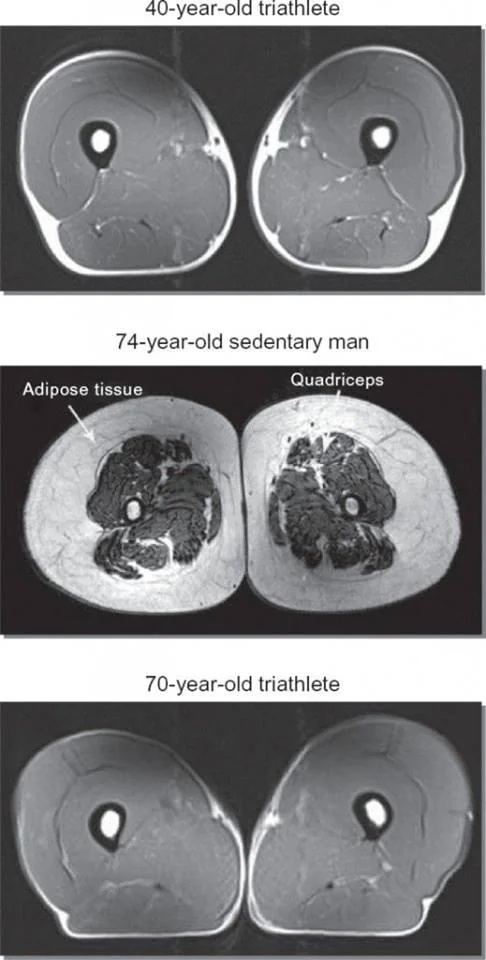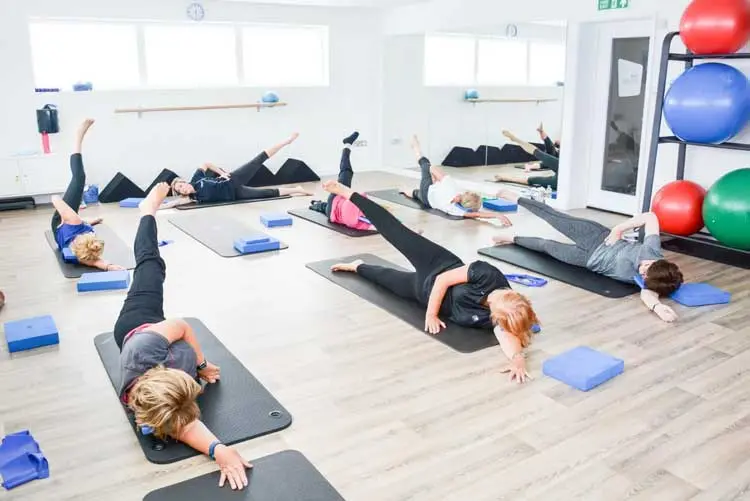As it’s International Day For Older People, it’s a good chance to focus on what helps people stay fit, healthy and active into the later years. We all know that it’s important to eat well, stay active, avoid too much alcohol, not smoke and to try and maintain a good body weight.
However, although there’s a big focus on body weight, what doesn’t get much attention is how much lean muscle mass you have or should have.
What is lean muscle mass?
Lean muscle mass is the amount of muscle that makes up your body composition. So you could have 2 people who look fairly similar from the outside or weigh the same, however, if you analysed the muscle mass of both people, one could have a much larger muscle mass and one a lower muscle mass underneath the skin.

Take a look at the images on the left. In the middle picture is the cross section of the leg of a sedentary 74 year old. You will see their thigh bone in the centre, surrounded by their quadriceps muscles (thigh muscles) and then the outer layer is fatty tissue. In the bottom picture, you can see that a 70 year old triathlete has in contrast a huge proportion of muscle mass (almost similar to that of the 40 year old in the top picture) and minimal fatty tissue.
Why does it matter?
The amount of lean muscle mass that you have contributes to your overall lean body mass. Lean body mass is very important. It’s not just about looking great or being stronger, sufficient amounts of lean body mass are actually critical for building a healthy life over the long-term.
- Lean body mass is associated with your Basal Metabolic Rate (BMR), the amount of calories you burn at rest. The greater amount of Lean Body Mass you have, the greater your BMR will be. This means that people with greater amounts of Lean Body Mass will have a greater energy expenditure while doing nothing, helping to avoid calorie imbalances, and ultimately, obesity.
- If you become ill or are stressed, your body’s nutritional demands increase as your immune system gets to work. An essential part of your immune system working well is protein. All this protein can’t come from food alone, so your immune system also relies on your protein reserves or your lean body mass. So, in short if you have a better lean body mass your body will find it easier to fight illness, infection or stress.
- Having a good lean body or muscle mass more specifically, helps protect against bones becoming weaker or thinner. Osteoporosis and frailty in later life put older people at great risk as they lead to falls and fractures. What is beneficial about optimising muscle mass is that you can increase bone strength and density.
In the medical field, loss of muscle mass is known as Sarcopenia. This is defined as the age-related loss of skeletal muscle mass and is a well-established factor associated with decreases in muscle strength and impaired mobility. The potential consequences of sarcopenia are frailty, physical disability, loss of independence and the depression that can accompany this; and the reduced ability to cope with major illnesses.
Subsequently, preventing the loss of or building lean muscle mass is a really crucial part of looking after your body.
What can I do to improve lean body mass?
DIET The earlier you can start developing or optimising your lean muscle mass the better, because as you age, it gets harder to improve muscle mass. However, the good news is, it’s never too late to start!
Diet plays a huge part. It’s outside the scope of this blog to explore the dietary factors, but if you want to look into this further, this website is a great resource and also has a database of professionals
MOVEMENT & EXERCISE There’s no easy way to improve lean body or muscle mass, it needs investment. Although cardio exercise like running, walking or swimming are great for improving and maintaining the health of your heart, lungs and circulation, to improve lean muscle mass you have to include specific types of exercise or activity to your routine. The best thing to do is some form of resistance training, so using light weights to exercise your muscle and build up strength and lean muscle mass. You can also do things like cycling, Pilates or yoga. Everyday activities like gardening, housework, shopping and childcare can also be pretty strenuous and will help too.
If you’re a little older and are worried about hitting the gym or starting exercises on your own, maybe think about seeing one of our Rehab Therapists for some individual guidance and support to help you get stronger and feel confident with exercising.
You can read more about Rehabilitation here or our Positive Steps exercise classes for older people here.



